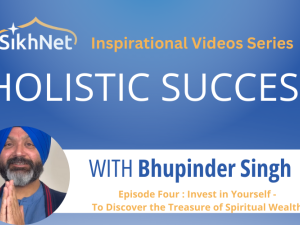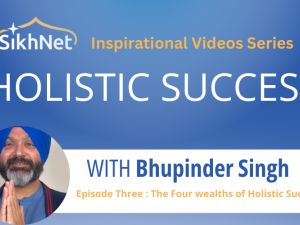Naam Realization – Part 3 of 4
Read Part I here
Read Part II here
7. Process of Naam realization
At this point, if one has fully comprehended Naam and its prominence in life, the obvious question should be what is the process to Naam Realization? Anand Sahib is a great elaboration of the process of Naam realization. Flow of Anand Sahib can be looked at like a pyramid for purpose of our understanding and simplicity. At tip of Pyramid is Ek Onkaar. The tip of Pyramid of Anand Sahib is Ek Onkaar because essence of Guru Granth Sahib is Ek Onkaar, and therefore when we read any Shabad the tip shall remain the same. Let’s explore this pyramid.
Step 0: Ek Onkaar
There are multiple elaborations of Ek Onkaar by various Gurus and Bhagats in SGGS. I will refer to two such elaborations.
On Ang 1418, Guru Amar Das ji writes :
ਹਰਿ ਮੰਦਰੁ ਹਰਿ ਸਾਜਿਆ ਹਰਿ ਵਸੈ ਜਿਸੁ ਨਾਲਿ ॥
Hari built the Har-Mandir, the temple of Hari. After building the Mandir, Hari dwells inside the Mandir.
This is the literal meaning. Literal meaning of Gurbani is just the surface appearance. Let us move deeper into the Bhaav or essence of this Shabad. The timeless and formless Hari or creator manifested itself as infinite number of forms, herein called mandir. Now Hari resides in the mandir or all forms that we see as the physical world, including you and me. Hari also resides outside the Mandir. Thus, there is nothing other than Hari. This is elaboration of Ek Onkaar. If we as Haume think otherwise, then we are Maya or illusion.
ਗੁਰਮਤੀ ਹਰਿ ਪਾਇਆ ਮਾਇਆ ਮੋਹ ਪਰਜਾਲਿ ॥
Through Guru’s Matt or teaching, one can meet Hari.
Again, lets go beyond literal meaning of Milna. Milna or Meeting here implies, realization that is nothing other than Hari. Upon realization that everything is Hari, illusions and attachments are burnt away. Attachment and illusion need two or more entities. Upon realization of one, there is nothing to be attached to or to be disillusioned of.
Here is second elaboration on Ang 463 by Guru Nanak Dev ji
ਆਪੀਨ੍ਹ੍ਹੈ ਆਪੁ ਸਾਜਿਓ ਆਪੀਨ੍ਹ੍ਹੈ ਰਚਿਓ ਨਾਉ ॥
The creator created itself; He Himself assumed His Name.
This is the literal meaning. Let us once again dive deeper for Bhaav of this panktis. Keep in mind that creator is neither masculine nor feminine. For sake of explanation the creator is referred to as He.
The creator created itself. (Sehbhang). This implies creator is all encompassing and is source of all virtues. Virtues of creator manifest as attributes in his creation. ਨਾਉ here refers to attributes imbued in every molecule of creation that we can experience and are able to relate to.
ਦੁਯੀ ਕੁਦਰਤਿ ਸਾਜੀਐ ਕਰਿ ਆਸਣੁ ਡਿਠੋ ਚਾਉ ॥
Secondly, He fashioned the creation; and is seated within the creation, He beholds it with delight.
The formless creator fashioned Kudrat or creation that we experience as the physical world or the universe. Further the creator is seated on his asan is within every molecule of creation and he is the delightful beholder. In other words, the formless creator is inside and outside the physical form. Thus there is nothing other than the creator itself.
If I claim to have any attributes to be mine, I become separated from creation in form of Haume. In this illusion I am bound to claim ownership thus becoming chained in attachment, which is beginning of suffering and pain. As Haume, my chest will puff when someone praises me and I will deflate like a balloon when someone does not compliment me. This infers to state of non-realization of Ek Onkaar.
Step 1: Anand or Naam realization
Let us begin with the first pankti.
“ਅਨੰਦੁ ਭਇਆ ਮੇਰੀ ਮਾਏ ਸਤਿਗੁਰੂ ਮੈ ਪਾਇਆ”
Guru ji states, that "I am in a state of Anand, because I have met Satguru."
Anand and Satguru are key words in first pankti. Let us understand both words.
Anand is a state of mind whereby one is unflustered through all ups and down of life, through success and failures, through pain and happiness. State of Anand points to virtue to fully comprehend good, bad and ugly without bias towards any of them. Anand is a state of mind, whereby one experiences life as miracle, no matter what is happening around them. Miracle or Karamat is whereby the karm is of karta and not mine. Gurbani also uses word Nihkaram, which implies dissolution of Haume, whereby all actions are rooted in Naam versus Haume.
Anand is Chardi Kala, whereby one remains unflustered due to immunity of Nir lepta because of Naam realization. State of Anand is possible when one understands the cosmic law or Hukam and abides by it without an iota of resistance. Anand is virtue of Naam. In other words, one can state, Anand is indication of realization of Naam. Anand is not happiness, as happiness has opposite state called pain. Happiness has an extrinsic reason, thus impermanent. Whereas Anand is an intrinsic state of being because of Naam realization. As Naam is one, there is no opposite state of Anand, thus it is eternal.
Step 2: Satguru
If Anand is an eternal state, why shall one seek the fake coin of happiness, that is bound to flip and turn into pain. Anand is the authentic coin. Such is the greatness of Naam realization that it provides a state of calm and peace in most adverse of conditions. Next imminent question is where do I find Satguru and why would Satguru bless me with Naam. Let us first understand what is Satguru from Guru Granth Sahib.
On Ang 758, Guru Ram Das ji talks about Satguru:
ਸਤਿਗੁਰੁ ਮੇਰਾ ਸਦਾ ਸਦਾ ਨਾ ਆਵੈ ਨਾ ਜਾਇ ॥
ਓਹੁ ਅਬਿਨਾਸੀ ਪੁਰਖੁ ਹੈ ਸਭ ਮਹਿ ਰਹਿਆ ਸਮਾਇ ॥੧੩॥
My Satguru is forever and ever. Satguru does not come into the cycle of birth and death, meaning Satguru does not have physical form. Satguru is the imperishable, immortal purkh. And Satguru is permeated and pervading in everyone.
These panktis shall banish all misconceptions and beliefs about definition of Satguru. This means Satguru is always present and does not take birth or dies. This clearly implies there is only one Satguru who is beyond realm of time and yet the same Satguru prevails within mortal beings. One who is seeking realization of Naam shall turn their attention inwards, instead of looking outwards for Satguru, because Satguru “ਸਭ ਮਹਿ ਰਹਿਆ ਸਮਾਇ”.
To understand how one can, find Satguru inside, let us go a little deeper into meaning of the word Satguru. Satguru is made up of two words, Satt and Guru. To understand meaning of word Satt, let us revert to Gurbani again. This Satt is referred to by Guru Nanak on Ang 1 of Granth Sahib,
ਆਦਿ ਸਚੁ ਜੁਗਾਦਿ ਸਚੁ ॥ ਹੈ ਭੀ ਸਚੁ ਨਾਨਕ ਹੋਸੀ ਭੀ ਸਚੁ ॥੧॥
True in The Primal Beginning. True throughout the Ages. True Here and Now. O Nanak, Forever and Ever True.
This Satt is Eternal Truth in form of Naam (Satt-nam) and the Guru who shows us to the path to Naam is called Satguru.
We need to be conscious to not derail train of our thoughts throughout the process of reading, comprehending and application of Gurbani. When we derail from the track provided in opening lines in SGGS, there will be loss of context. This can easily lead to misinterpretation of Bani. The track of Ek On Kar is provided by Guru Nanak upon his realization of Naam. The track of Oneness shall be to walk as one, to realize Naam.
As we evolve at level of our mann moving from “I” self or Haume towards “We” self or Naam, our awareness or Surt is lifted if it remains imbued in Shabad. Shabad as Guru, also appears to evolve for us. Satguru is evolved form of Shabad Guru.
Shabad Guru is wisdom that we acquire through our five senses from written words of realized masters, whereas Satguru is also the same wisdom, though it erupts from within us as our mann transforms into its essence, aka Jot or Braham Gyan.
Satguru is invocation of Bibek matt in our mann. Invocation of Braham Gyan from inside is meeting with Satguru. At this point, when we as Mann start serving or doing Seva of Satguru, we have begun the process of Naam Realization. Our Mann follows Satt. Our actions align with Satt further invoking virtues of Satt in our life. Outward transformation begins with inner transformation of our Mann.






